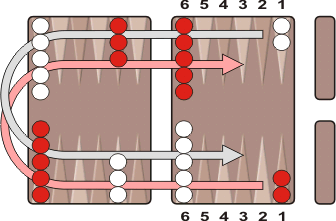![[Backgammon Galore!]](/gif/GaloreButton.gif)
|
|
Backgammon Variants Setup: The setup in Irish is the same as in backgammon. Each player has fifteen checkers: two on the opponent's one-point, five on the opponent's twelve-point, three on the player's eight-point, and five on the player's six point.
Object: The object of the game is to bring your checkers around the board to your home table, and then bear them off. The first player to bear off all his checkers wins the game. To start: Each player rolls one die and the higher number goes first. That player then rolls both dice again to begin his first turn. Movement: The roll of the dice indicates how many points, or pips, the player is to move his checkers. The following rules apply:
Note that doubles are played as any other roll: each number once (not twice as in backgammon). Hitting: A checker sitting alone on a point is called a blot. If an opposing checker lands on a blot, the blot is hit and placed on the bar. Entering from the bar: Any time you have one or more checkers on the bar, your first obligation is to reenter those checker(s) into the opponent's home board. You reenter a checker by moving it to an open point corresponding to one of the numbers on the rolled dice. If you are able to enter some but not all of your checkers on the bar, you must enter as many as you can then give up the remainder of your turn. Binding the tables: This rule is unique to Irish: You are not allowed to have a closed home board when the opponent has a checker on the bar. If you do, then the players each roll one die. The player rolling the larger number decides which point of your home board you must open. All but one checker from the nominated point is removed and placed on the bar. This checker or checkers must now be reentered as if they had been hit. Bearing off: Once you have brought all your checkers into your own home board, you may begin bearing off. You bear off a checker by rolling a number greater than or equal to the number of the point on which that checker resides. You do not have to bear off exactly, and you always have the option of making a normal move with a different checker when such a move is available. This is a little different than in backgammon. In Irish, you may bear off from a lower-numbered point even if a higher point still has checkers on it. Scoring: The first player to bear off all of his checkers wins the game. There is no bonus for a gammon or a backgammon. No doubling cube is used in this game.
References
|
![]()
Backgammon Galore : Variants

